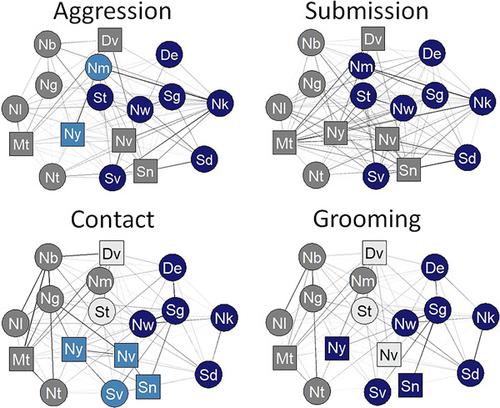当前位置:
X-MOL 学术
›
Am. J. Primatol.
›
论文详情
Our official English website, www.x-mol.net, welcomes your feedback! (Note: you will need to create a separate account there.)
Dominance and social interaction patterns in brown capuchin monkey (Cebus [Sapajus] apella) social networks
American Journal of Primatology ( IF 2.4 ) Pub Date : 2022-01-24 , DOI: 10.1002/ajp.23365 Regina Paxton Gazes 1, 2 , Allie E Schrock 1, 3 , Corinne N Leard 1 , Meredith C Lutz 1, 4, 5
American Journal of Primatology ( IF 2.4 ) Pub Date : 2022-01-24 , DOI: 10.1002/ajp.23365 Regina Paxton Gazes 1, 2 , Allie E Schrock 1, 3 , Corinne N Leard 1 , Meredith C Lutz 1, 4, 5
Affiliation

|
Strong, stable social bonds in primates are characterized by high levels of social affiliation, low levels of aggression, minimal stress, and affiliative reciprocity within the dyad. In relatively well-studied catarrhine monkeys, these bonds tend to form most frequently between kin, animals close in age, and animals close in rank. This results in patterns of affiliation in which kin, similarly aged animals, and like-ranked animals tend to affiliate and patterns of aggression and submission where animals tend to aggress more toward nonkin and closely ranked animals, and submit more toward distantly ranked animals. However, literature on how affiliative and agonistic relationships are organized in platyrrhine primate species like brown capuchin monkeys is limited and conflicting. In this study, we used social network analyses to characterize how age, sex, maternal kinship, and dominance rank relate to the patterns of submissive, aggressive, contact, and grooming interactions in a group of captive brown capuchin monkeys. Like catarrhine monkeys, brown capuchin monkeys showed a steep linear dominance hierarchy, tended to affiliate with kin, similarly aged animals, and like-ranked animals, and tended to aggress more toward nonkin. However, our monkeys showed a pattern of affiliation and grooming down the hierarchy that is inconsistent with grooming up the hierarchy patterns often seen in catarrhine monkey groups, suggesting that brown capuchins do not compete for access to higher ranking social partners. Higher ranking monkeys were most central to the aggression network, and lower ranking monkeys were most central to the submission network. Mid-ranking monkeys were the most central to the contact network, suggesting that they may play an important role in the affiliative cohesion of the group. These results inform our understanding of brown capuchin social behavior specifically, and of how demographic factors relate to social organization in platyrrhine primates generally.
中文翻译:

棕色卷尾猴 (Cebus [Sapajus] apella) 社交网络中的优势和社交互动模式
灵长类动物中强大、稳定的社会纽带的特点是社会归属感高、攻击性低、压力最小以及二人组内的归属互惠。在相对充分研究的卡他因猴中,这些联系往往最常在亲属、年龄相近的动物和等级相近的动物之间形成。这导致了从属关系模式,其中亲属、年龄相近的动物和排名相似的动物倾向于从属关系以及攻击和服从模式,其中动物倾向于更多地攻击非亲属和排名靠前的动物,而更多地屈服于排名较远的动物。然而,关于如何在像棕色卷尾猴这样的鸭嘴兽灵长类物种中组织从属关系和激动关系的文献是有限且相互矛盾的。在这项研究中,我们使用社交网络分析来描述年龄、性别、母系亲属关系和支配等级与一组圈养棕色卷尾猴的顺从、攻击、接触和梳理互动模式有关。像卡他林猴一样,棕色卷尾猴表现出陡峭的线性支配等级,倾向于与近亲、年龄相近的动物和等级相似的动物有联系,并且倾向于对非近亲更具攻击性。然而,我们的猴子表现出一种从属关系和向下梳理的模式,这与在卡他林猴群中常见的向上梳理层次模式不一致,这表明棕色卷尾猴不会竞争获得更高等级的社会伙伴。排名较高的猴子对攻击网络最为核心,而排名较低的猴子对提交网络最为核心。中级猴子是联系网络中最核心的,这表明它们可能在群体的凝聚力中发挥重要作用。这些结果有助于我们具体了解棕色卷尾猴的社会行为,以及人口统计学因素如何与鸭嘴兽灵长类动物的社会组织相关。
更新日期:2022-01-24
中文翻译:

棕色卷尾猴 (Cebus [Sapajus] apella) 社交网络中的优势和社交互动模式
灵长类动物中强大、稳定的社会纽带的特点是社会归属感高、攻击性低、压力最小以及二人组内的归属互惠。在相对充分研究的卡他因猴中,这些联系往往最常在亲属、年龄相近的动物和等级相近的动物之间形成。这导致了从属关系模式,其中亲属、年龄相近的动物和排名相似的动物倾向于从属关系以及攻击和服从模式,其中动物倾向于更多地攻击非亲属和排名靠前的动物,而更多地屈服于排名较远的动物。然而,关于如何在像棕色卷尾猴这样的鸭嘴兽灵长类物种中组织从属关系和激动关系的文献是有限且相互矛盾的。在这项研究中,我们使用社交网络分析来描述年龄、性别、母系亲属关系和支配等级与一组圈养棕色卷尾猴的顺从、攻击、接触和梳理互动模式有关。像卡他林猴一样,棕色卷尾猴表现出陡峭的线性支配等级,倾向于与近亲、年龄相近的动物和等级相似的动物有联系,并且倾向于对非近亲更具攻击性。然而,我们的猴子表现出一种从属关系和向下梳理的模式,这与在卡他林猴群中常见的向上梳理层次模式不一致,这表明棕色卷尾猴不会竞争获得更高等级的社会伙伴。排名较高的猴子对攻击网络最为核心,而排名较低的猴子对提交网络最为核心。中级猴子是联系网络中最核心的,这表明它们可能在群体的凝聚力中发挥重要作用。这些结果有助于我们具体了解棕色卷尾猴的社会行为,以及人口统计学因素如何与鸭嘴兽灵长类动物的社会组织相关。



























 京公网安备 11010802027423号
京公网安备 11010802027423号